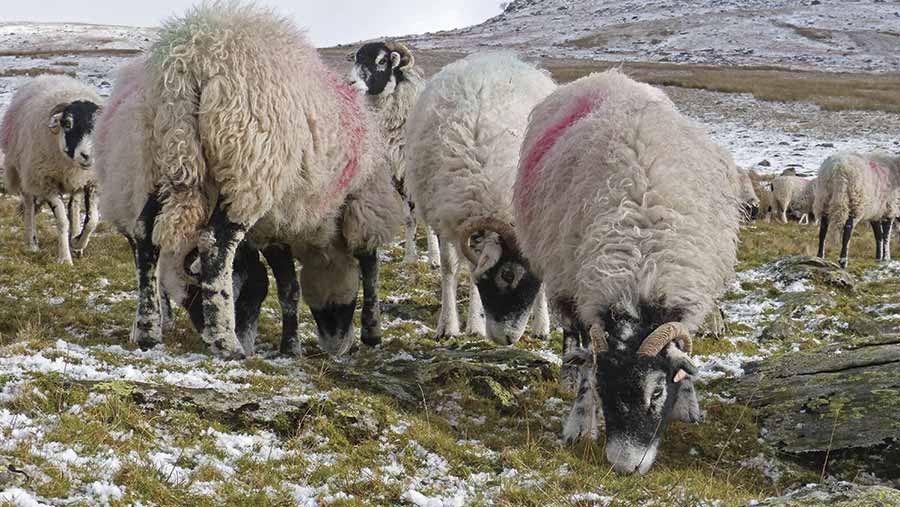Nutrition advice to convert higher hill scanning rates

Meeting the increased energy requirements of twin-bearing sheep should be a key focus on many hill farms this winter, says independent ruminant nutritionist Paul Keable of PK Nutrition.
Given the trend in higher scanning rates, Mr Keable says it is wise to test forage to calculate the nutritional intake of ewes to ensure bigger lamb crops are realised at lambing time.
“Ewes returned to the hill post-tupping need to maintain forage intake if they are to stay in condition,” says Mr Keable. “A major cause of low intakes is mineral and vitamin deficiency. We see a marked improvement in ewes keeping condition having had free access minerals.”
See also: Swaledale breeders embark on performance-recording project
Analyse silage
He says a 65kg twin-bearing ewe six weeks before lambing should eat at least 1kg of dry matter to meet her 10.5ME energy requirement, the same as a larger 75kg lowland dry ewe.
“This is equal to just over 1ME per 6kg body weight,” explains Mr Keable. “Knowing what’s in your silage allows you to calculate the intake of your ewes. This can give you a warning that something may be amiss, whether it’s a protein/energy imbalance or a deficiency.”
Excess protein affects energy
He stresses that it is useful to understand what rumen degradable protein (RDP) there is in the forage in ratio to fermentable metabolisable energy (FME is the proportion of the metabolisable energy that is available to the rumen).
“This ratio should be 10:1,” explains Mr Keable. “For every 1 FME there should be 10g of RDP, with any shortfall in protein made up with bypass protein. Silage often has a ratio of more than 10 to 1, and so do a lot of cakes.
“One month from lambing, a 65kg ewe carrying a single lamb needs 11ME and 90g of protein, for twins she needs 12.5ME and 98g,” he explains.
He warns that overfeeding protein is quite common when feeding cakes and silages with more rumen available protein than fermentable energy, and can affect a ewe’s energy.
“Excess rumen available protein doesn’t pass through the gut, it degrades into ammonia, then passes through the rumen wall into the blood stream before being converted into urea via the liver and excreted in the urine. It is a long process, requiring energy, and the larger the protein excess the more it impacts the ewe.
“Let’s suppose an 18% crude protein cake is well-balanced, it should supply all of the above ewe’s protein needs in half a kilo, never mind what’s in the forage.”
Body condition requirements
Research into twin-bearing hill ewes suggested that these sheep could benefit from maintaining a body condition score of 2.5 from tupping through mid-gestation, although this is based on “limited data”.
Dr Liz Genever of AHDB Beef & Lamb said the initiative Challenge Sheep could shed light on this issue. The new AHDB Beef & Lamb-funded project aims to understand the consequences of the rearing phase on the lifetime performance of ewes.
She said forage intakes could be affected by feeding methods (floor, racks or snacker), but that methods depended on specific farms and labour arrangements.
She added that high protein feed block or buckets were convenient but had the down side of being expensive.
“It could be worth considering strategic use of creep feed for groups of young or thin ewes with twin lambs. Grassland can be optimised through soil tests and nutrient management on in-bye land.”
‘Swaledales are more prolific today’
Many upland farms in northern England now scan nearer 150%, whereas scanning round the 100% mark was more common previously, says sheep scanner and farmer Adrian Bell, who farms at Thringill, Nateby, Kirkby Stephen.
“It’s hard to generalise and some flocks, for various reasons, have seen scanning results fall recently, but 130% is a more typical fell scanning result nowadays,” says Mr Bell, who has maintained detailed records since 1998 that confirm high scanning results in the hills.
This year’s results ranged from 100% to highs of 189%, with 27 of the 49 farms scanning at between 130% and 160%.
He says: “Various management practices could be driving this, as well as genetics. Modern farming methods mean sheep are being farmed better, while some flocks winter away from the hills due to winter grazing restrictions.
“But there has also been a change in breeding from tups that are twins. Some Swaledale breeders will still not breed from tups that were born as twins, but attitudes to breeding from twins seems to have changed and prolificacy has a genetic element to it.”
Hill farm scanning figures 2017
|
Statistic |
2017 season |
2016 season |
% change |
|
Averaging lambing % |
146.6% |
145.5% |
+0.6% |
|
Average % barren |
5.25% |
5.92% |
-11.32% |
|
Average flock size |
663.3 |
641.7 |
+3.36% |
* The data is taken from 49 hill farms from Mr Bell’s scanning round of over 300 farms mainly in the upland areas of Weardale, Teesdale, Swaledale, Wensleydale and the Upper Eden Valley.
